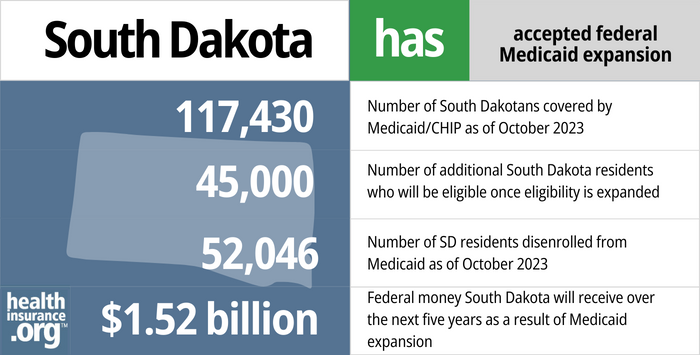
Medicaid eligibility and enrollment in South Dakota
Medicaid expansion took effect July 1, 2023, after passage of 2022 ballot measure

Who is eligible for Medicaid in South Dakota?
Medicaid in South Dakota (also called the South Dakota Medical Assistance Program, which includes both Medicaid and CHIP) is available to eligible low-income households (note that all of these income limits include a built-in 5% income disregard that’s used for MAGI-based Medicaid eligibility):
- Pregnant women with household incomes up to 138% of the federal poverty level (FPL). Starting in July 2023, postpartum Medicaid coverage for new mothers will continue for 12 months after the baby is born (instead of ending after 60 days).
- Children aged 0 to 18 with household income up to 187% of FPL are eligible for Medicaid; Children with household incomes up to 209% of poverty are eligible for CHIP (Children’s Health Insurance Program).
- Starting in July 2023, adults under age 65 are eligible for Medicaid with income up to 138% of the poverty level. Eligible adults could begin applying for expanded Medicaid coverage starting June 1, 2023, with coverage effective in July. Prior to July 2023, parents with dependent children were eligible with incomes up to 63% of poverty, but other adults were not.
for 2026 coverage
0.0%
of Federal Poverty Level
Apply for Medicaid in South Dakota
Apply year round through HealthCare.gov or by phone at 1-800-318-2596. Download applications for Medicaid and CHIP from the South Dakota Department of Social Services website; then mail, fax, or take the application in person to a local Social Services office. Have questions? Call (605) 773-3165.
Eligibility: Pregnant women with household incomes up to 133% of FPL; children with household incomes up to 204% of FPL (for CHIP); parents with dependent children are eligible with incomes up to 58% of FPL.

Medicaid eligibility expanded in July 2023 (applications accepted starting June 1)
South Dakota is one of 12 states where federal funding to expand Medicaid was consistently rejected by the legislature and governor. But the issue was put to the state’s voters in the 2022 election, and voters approved Medicaid expansion by a 56% to 44% margin. The measure called for the state to expand Medicaid eligibility on July 1, 2023.
South Dakota received federal approval to initiate expansion as of July 2023, and for the specific benefits package that the newly eligible population is receiving. Under the new eligibility guidelines, a single adult will qualify for Medicaid in South Dakota with an income of up to about $20,120. (That number increases a little each year, and is based on the 2023 poverty level.)
An estimated 52,000 low-income South Dakota residents are newly eligible for Medicaid under the expanded eligibility guidelines. Residents could begin submitting applications for expanded Medicaid on June 1, 2023.
Over the next five years, South Dakota will receive nearly $1.35 billion in additional federal Medicaid funding due to the eligibility expansion.
Medicaid expansion via ballot measure has been successful in all of the states where voters have had an opportunity to directly decide whether the state should expand Medicaid. This includes Maine, Utah, Idaho, Nebraska, Oklahoma, and Missouri.
- 117,430 – Number of South Dakotans covered by Medicaid/CHIP as of October 20231
- 45,000 – Number of additional South Dakota residents who will be eligible once eligibility is expanded2
- 52,046 – Number of SD residents disenrolled from Medicaid as of October 20233
- $1.52 billion – Federal money South Dakota will receive over the next five years as a result of Medicaid expansion

Explore our other comprehensive guides to coverage in South Dakota

We’ve created this guide to help you understand the South Dakota health insurance options available to you and your family, and to help you select the coverage that will best fit your needs and budget.
Learn about health insurance coverage options in South Dakota.


Looking to improve your smile? Dental insurance may be a smart addition to your health coverage. Our guide explores dental coverage options in South Dakota.


As of late 2022, there were 190,708 residents enrolled in Medicare in South Dakota.4 Learn more about Medicare Parts A, B, C and D plans and Medicare Supplement insurance (Medigap) plan availability in South Dakota.


As of 2023, there were at least five insurers selling short-term health insurance plans in South Dakota.5
Learn about short-term insurance regulations in South Dakota.

Frequently asked questions about South Dakota Medicaid
How do I apply for Medicaid in South Dakota?
Medicaid enrollment is open year-round. You can apply for South Dakota Medicaid online, over the phone, or by submitting a paper application. If you have questions, you can reach the SD Department of Social Services at 1-605-773-3165.
- Online: Visit HealthCare.gov or South Dakota DSS online
- By phone: Call HealthCare.gov at 1-800-318-2596.
- Paper applications: Download an application for Medicaid or CHIP from the South Dakota Department of Social Services website. The application must then be mailed, faxed, or taken in person to a local Social Services office.
How does Medicaid provide financial assistance to Medicare beneficiaries in South Dakota?
Many Medicare beneficiaries receive Medicaid’s help with paying for Medicare premiums, affording prescription drug costs, and covering expenses not covered by Medicare – such as long-term care.
Our guide to financial assistance for Medicare enrollees in South Dakota includes overviews of these benefits, including Medicare Savings Programs, long-term care coverage, and eligibility guidelines for assistance.
How is South Dakota handling Medicaid renewals after the pandemic?
Throughout the COVID pandemic, from March 2020 through March 2023, states were not allowed to disenroll anyone from Medicaid, even if they no longer met the eligibility criteria (some states chose to apply this continuous coverage rule to their CHIP populations as well, but South Dakota did not). The federal continuous coverage requirement ended March 31, 2023, and states could resume routine disenrollments as early as April 1. The end of the continuous coverage rule is being referred to as “unwinding,” and it’s expected to take a year for states to process eligibility redeterminations for everyone enrolled in Medicaid.
South Dakota opted to begin the return to normal eligibility redeterminations and disenrollments as soon as allowed under federal rules, with renewal processing beginning in February 2023 and disenrollments possible as of April 1 (only four other states opted to have their initial round of disenrollments effective in April).
According to South Dakota’s enrollment data page, total Medicaid enrollment dropped from 152,987 in March to 139,770 in April, and to 131,627 in May. So in just the first two months, enrollment had dropped by more than 21,000 people, amounting to nearly 14% of the people who had Medicaid in March. But as noted above, some of those people are likely eligible for Medicaid again now that expanded eligibility rules for adults have taken effect.
An enrollee’s coverage will continue until their renewal date, even if they no longer meet the eligibility guidelines. South Dakota expects to take nine months to work through all of the renewals for people who are most likely to no longer be eligible for Medicaid, so some enrollees who are no longer eligible will not have their renewal processed until late 2023. The state had noted that they had about 22,000 enrollees who “appear ineligible” for Medicaid. But before they can be removed from the program, their ineligibility has to be verified.
For each month’s renewals, the state will first try to auto-renew coverage based on existing data. But for those whose coverage cannot be auto-renewed, the state will send a renewal packet (marked “urgent”) with instructions for completing the renewal on paper, online, over the phone, or in person at a county office. The packet will be sent out about six weeks before the coverage is due to renew.
South Dakota is in a unique position during the unwinding process, as Medicaid expansion took effect in the state in July 2023, just three months after the first round of disenrollments due to the end of the COVID-related continuous coverage rule. Some people who lost Medicaid in April, May, or June will find that they’re once again eligible for Medicaid starting in July, under the new expansion rules (for those whose renewal date is July or later, they would not lose coverage in that case, but would simply transition to the Medicaid expansion eligibility category). So for those individuals, the state was screening for potential eligibility under the expansion guidelines and letting the person know that they should reapply starting in June (for coverage effective July 1). Reminder notices about this were sent to these individuals in June.
People who are no longer eligible for Medicaid will generally find that they can either enroll in an employer’s plan (if available), or sign up for a plan through the South Dakota marketplace/exchange. Most exchange enrollees qualify for substantial income-based subsidies to offset the cost of their coverage (and in some cases, their out-of-pocket costs).
Does South Dakota have a Medicaid work requirement?
No, although the state sought federal approval to implement a work requirement. Instead of expanding Medicaid during any of the legislative sessions since 2010, South Dakota opted to seek federal approval for a pilot program work requirement for low-income parents in the existing Medicaid program (the pilot program would have applied in just two counties initially).
Former Governor Dennis Daugaard laid out the details of the work requirement in his State of the State address in January 2018, and the state published the proposed waiver application in May 2018. The waiver proposal has been pending CMS approval since 2018, but the Biden administration notified states in 2021 that Medicaid work requirements were essentially a non-starter; all of the previously approved work requirements were revoked by the Biden administration in 2021, and no pending work requirement proposals have been approved. South Dakota began voluntary enrollment in the Career Connector program in July 2018.
Legislation impacting South Dakota Medicaid
South Dakota Medicaid history
South Dakota’s Medicaid program became effective in October 1967, nearly two years after Medicaid was created. For many states, 2014 represented a significant shift in eligibility, particularly for childless adults. However, South Dakota Medicaid eligibility guidelines have not yet changed under the ACA. Non-disabled childless adults are ineligible for Medicaid, regardless of how low their incomes are. But as noted above, that might change after voters have an opportunity to weigh in on Medicaid expansion on the 2022 ballot.
South Dakota Medicaid expansion history
South Dakota expanded Medicaid in July 2023, nearly a decade after Medicaid expansion took effect in many other states. Former Governor Dennis Daugaard supported Medicaid expansion by 2015 (after initially opposing it), but the issue did not have lawmakers’ support. Current Governor Kristi Noem is opposed to Medicaid expansion, and the legislature has also continued to oppose Medicaid expansion. But as has been the case in every other state where voters got to weigh in directly on the issue, South Dakota voters approved a constitutional amendment (Amendment D) to expand Medicaid eligibility as called for in the ACA.
South Dakota officials announced in September 2015 that their proposal to expand Medicaid had received “an initial go-ahead” from HHS. then-Governor Dennis Daugaard’s senior advisor Kim Malsam-Rysdon noted that the plan was still preliminary, but it appeared promising and would have expanded eligibility to far more people than the state’s 2014 proposal, which would only have expanded coverage to residents with incomes below the poverty level (HHS rejected that proposal, as Medicaid expansion capped at the poverty level — but with the enhanced federal Medicaid expansion funding match — was a non-starter under the Obama administration, and was also rejected by the Trump administration when proposed by Utah and Georgia).
Although states that expanded Medicaid are paying 10% of the cost, Daugaard noted that his proposal would have ended up being a financial net positive for the state. That’s because he was working with the federal government and Native American tribal leaders to use Medicaid funding for Native Americans who would become eligible for expanded Medicaid and who receive treatment outside of Indian Health Services (IHS) facilities. Those costs are covered in part by the state, and Daugaard said that South Dakota would save more there than it would spend on its portion of the Medicaid expansion costs. Daugaard said that he wouldn’t continue his push for Medicaid expansion if it ended up needing additional money from the state’s general fund.
In December 2015, Governor Daugaard explained the details of his $4.8 billion budget proposal, including his proposal to expand Medicaid to cover 55,000 people who weren’t currently eligible. Daugaard said that the state should “seize the opportunity” to use federal funding to expand coverage, if possible.
In February 2016, HHS agreed to establish arrangements under which non-IHS providers could enter into “care coordination agreements” with IHS facilities, and Native Americans enrolled in Medicaid would be able to receive care at those non-IHS facilities and the full cost would be covered by federal Medicaid funds (as opposed to the state paying a portion and the federal government paying a portion). But Daugaard noted that the practical implementation of the new HHS provision could be complicated, and that there was still work to be done to determine whether the savings from the new IHS rule would save enough money to make Medicaid expansion budget-neutral in South Dakota.
A few days later, Daugaard said that it was too late in the 2016 legislative session to get the ball rolling on Medicaid expansion, and said that he would remove Medicaid expansion from his proposed budget. He indicated that a special session was a possibility, but that waiting until the 2017 legislative session was also a possibility. In June 2016, Daugaard confirmed that the issue would have to wait until the 2017 legislative session, as he was opting not to call a special session in 2016.
In early 2017, in his State of the State address, Daugaard noted that he was optimistic about working with the Trump administration to ensure that the federal government would begin to fully fund medical care for Native Americans, regardless of where the care was provided, without requiring “health care providers to jump through several hoops,” as he believed the Obama-era arrangement did. He did not mention Medicaid expansion in that address.
The issue of Medicaid expansion was essentially off the table in South Dakota as of early 2017. The coalition tasked with recommending how the state should expand coverage updated their conclusions in December 2016 to note that Governor Daugaard was no longer recommending Medicaid expansion for 2017, in light of the incoming Trump administration’s plans to overhaul Medicaid nationwide with block grants or per-capita allotments. Ultimately, that did not come to pass at the federal level, but no progress was made toward Medicaid expansion in South Dakota in the meantime.
Kristi Noem took office as governor in 2019, and opposes Medicaid expansion. But voters in the state had an opportunity to decide the matter for themselves on the 2022 ballot, and they approved Medicaid expansion. Most of the states that have expanded Medicaid have done so via legislation. But as time goes on and lawmakers and/or governors in a dwindling number of states continue to reject federal funding to expand Medicaid, the issue is increasingly being taken directly to voters.
In order to get the measure on the ballot, Medicaid expansion supporters in South Dakota gathered more than 38,000 signatures. There were concerns that the measure might need 60% approval to pass, as voters also had the opportunity to vote on South Dakota Constitutional Amendment C in the June 2022 primary election. That measure was defeated, but if it had been approved it would have required 60% voter approval for future ballot measures that increased taxes or require the state to appropriate more than $10 million. If voters had approved Amendment C, Amendment D would have needed to be approved by at least 60% of voters in order to pass. But since Amendment C did not pass, Amendment D only needed a simple majority in order to pass (it ultimately got 56% of the vote).
Footnotes
- “October 2023 Medicaid & CHIP Enrollment Data Highlights”, Medicaid.gov, Accessed November 2023 ⤶
- “Total Monthly Medicaid & CHIP Enrollment and Pre-ACA Enrollment”, KFF.org, Accessed November 2023 ⤶
- “Medicaid and CHIP National Summary of Renewal Outcomes – March through July 2023”, Medicaid.gov, October 2023 ⤶
- “Medicare Monthly Enrollment ” CMA.gov, April 2023. ⤶
- “Availability of short-term health insurance in South Dakota” healthinsurance.org, March 8, 2023 ⤶

